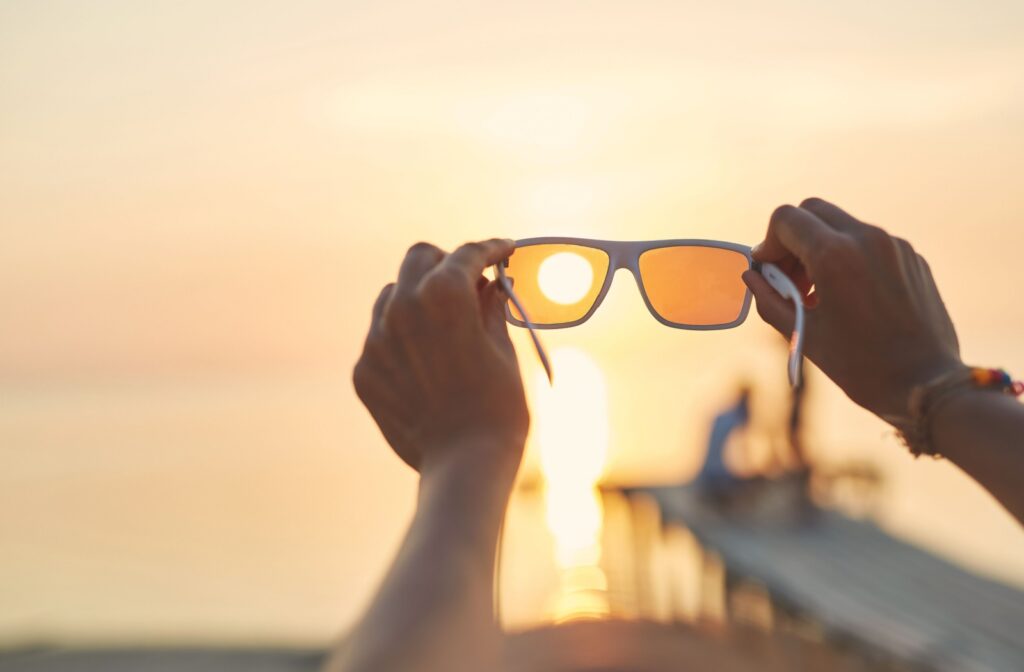If you’ve ever wondered whether it’s safe to look directly at the sun while wearing sunglasses, you’re not alone. It’s a common question, and many people assume that UV protection is enough to make looking at the sun safe. But this is a dangerous misconception.
You should never look directly at the sun, even with sunglasses or polarized sunglasses. It’s always a good idea to understand the risks of UV exposure to our eye health. UV radiation is linked to eye conditions like photokeratitis, solar retinopathy, cataracts, and more.
Never Look Directly at the Sun
Staring at the sun, even for a short time, can damage your eyes.
When UV light from the sun enters the eye, it passes through the lens and focuses on the retina. When UV rays are absorbed by the retina, this leads to the creation of free radicals that can oxidize tissues and damage the retina’s photoreceptors. The result is a condition known as solar or photic retinopathy. The damage can occur in just a few seconds, and symptoms may not be apparent for several hours.
You should never look directly at the sun, even with sunglasses. Nor should you look at the sun through binoculars, telescopes, or camera lenses. Viewing the sun through telescopes and binoculars may be particularly dangerous.
During a solar eclipse, the only time you can look at the sun without protection is during totality, when the moon completely covers up the sun. Otherwise, the National Aeronautics and Space Administration (NASA) recommends using eclipse glasses or a solar viewer.
Eye Conditions Linked to UV Rays
Excessive exposure to UV radiation can lead to several serious eye conditions, from snow blindness to growths called pterygium.
Solar Retinopathy
Solar retinopathy is damage to your retina, which is an area of tissue at the back of your eye. Photoreceptors in the retina turn light into electrical signals, which are then relayed to the brain through the optic nerve.
Solar retinopathy can happen to people who look directly at the sun. It can also be caused by other light sources such as welding arcs and laser pointers. Symptoms range from watery eyes and headaches to pain, vision distortions, and blind spots, and you may not notice symptoms for several hours or days after light exposure.
Photokeratitis & Snow Blindness
Photokeratitis is a painful condition that impacts the conjunctiva and the surface of the cornea. It can be caused by UV radiation from sources like tanning beds, arc welding, and looking directly at the sun. It can also be caused by light reflected off water and snow, a condition sometimes referred to as “snow blindness.”
Symptoms of photokeratitis may not be immediately noticeable, but they include pain, redness, light sensitivity, swelling, and, in rare cases, loss of vision. Cold compresses and artificial tears can help during the recovery process.

Pterygium
Also called “surfer’s eye,” pterygium is an abnormal growth on the eye’s conjunctiva and cornea. These growths are attributed to sun exposure and are more common in tropical areas. They can take months or years to grow, and symptoms may include irritation, redness, astigmatism, and fuzzy vision. The pterygium itself may appear as white or pink tissue on top of the eye. Serious cases may require surgery, but pterygium often grow back.
Other Conditions
Sun exposure has also been linked to cataracts. Some types of cancer and age-related macular degeneration (AMD) have also been associated with UV radiation, but research on their connection is ongoing.
The bottom line: the sun poses very real health risks to our eyes and vision. But this doesn’t mean we can’t go outside! With proper sun protection, going outdoors and being active in the sun can promote health and well-being.
Sun Safety & Your Eyes
When it comes to sun protection, simplicity goes a long way. Consider the following tips:
- Wear a dark and wide-brimmed hat that shields your eyes from the sun.
- The sun is typically strongest between 10 am and 4 pm, so consider avoiding the sun or scheduling indoor activities during these hours.
- Choose sunglasses that fit well and cover a substantial area, including your eyes and the skin around them. Buy sunglasses that offer 99-100% UVA and UVB protection, or look for a UV400 rating. Try polarized lenses if you do activities in water, ice, and snow.
How Sunglasses Help
Many sunglasses are designed to block harmful UVA and UVB rays from the sun. They can also help prevent headaches and eye strain, and offer protection against wind, dust, and glare. They can even shield your skin from the sun, helping prevent skin cancer and wrinkles.
It’s also a good idea to consider the color of your lenses. Brown or amber tints may be more helpful for people with macular degeneration or diabetic retinopathy because they promote contrast. On the other hand, brown, gray, yellow, and green tints may be more suitable for driving. Bottom line: choose sunglasses with high UV protection.
Sun exposure is cumulative over a lifetime, so even children as young as 6 months should wear sunglasses.
When in Doubt, Seek Help
Sun exposure can cause eye conditions with worrisome symptoms. If you have any concerns, contact your optometrist or other healthcare provider.
Symptoms like eye pain and vision loss warrant medical attention. Remember that symptoms of sun damage may take hours or days to show up, so mention UV exposure if you’ve experienced it in previous days.
Take Care of Your Eyes in Sunny Chula Vista
As optometrists in Chula Vista, we understand and appreciate the pleasures of the California sun! To help protect your eyes on sunny days, our optometry clinic offers a variety of sunglasses for you to peruse. And if it’s time for you to get your eyes checked, we offer comprehensive eye exams for adults and children.
Have questions about eye health? Don’t hesitate to reach out to us at Pack & Bianes Optometry.
Book an appointment today.



